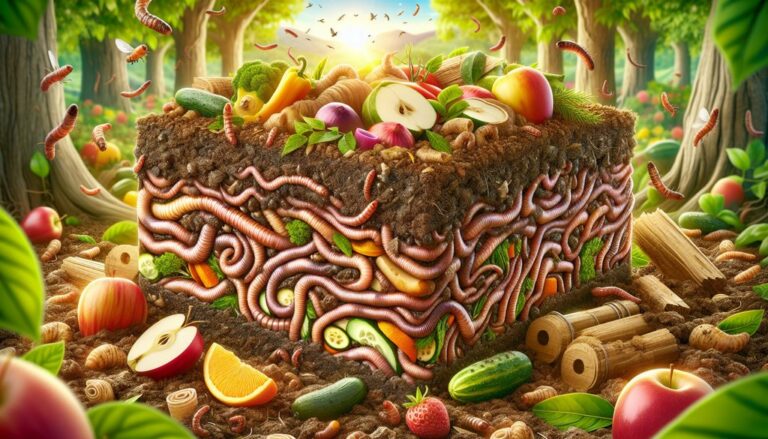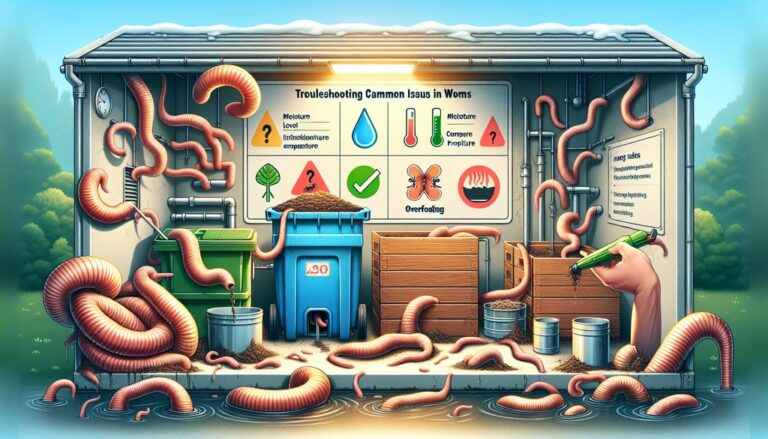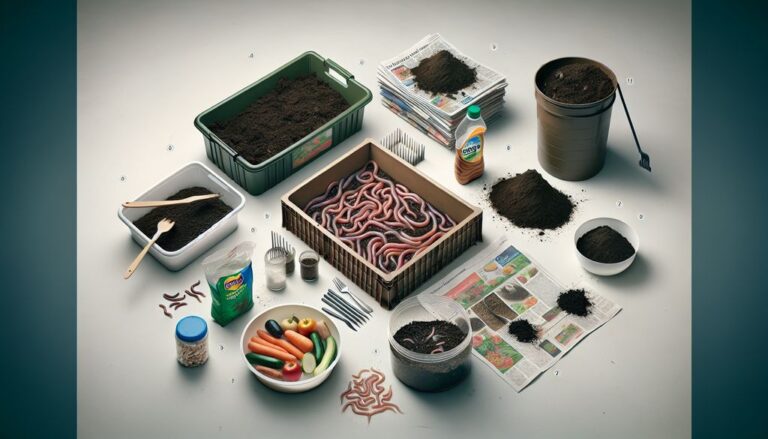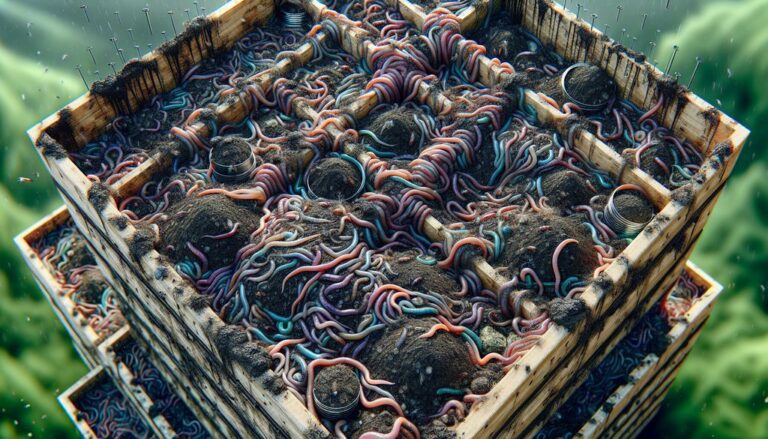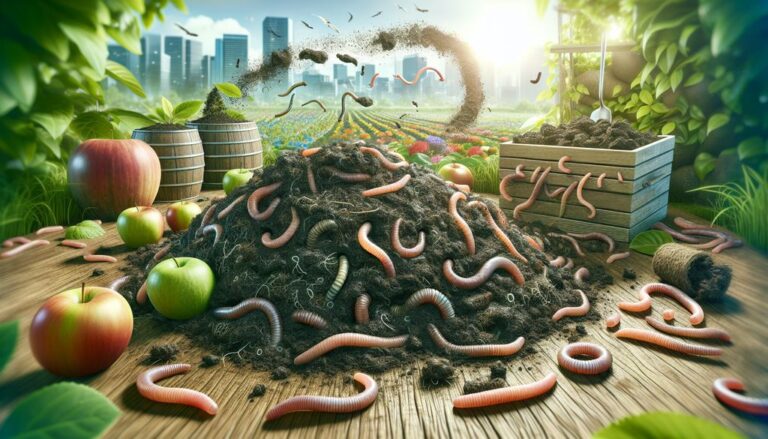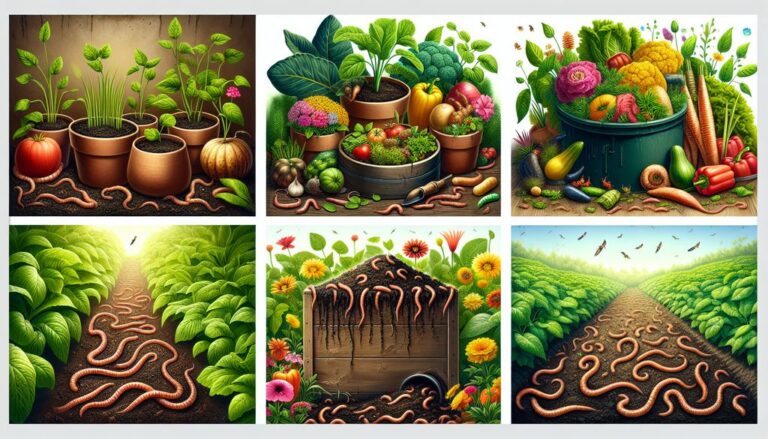Vermicomposting is a fascinating and eco-friendly method of composting that utilizes worms to break down organic materials into nutrient-rich compost. This sustainable practice not only reduces waste and landfill use but also provides a valuable source of natural fertilizer for plants and gardens. In this article, we will explore 10 key facts about vermicomposting that will give you a deeper understanding of this sustainable practice. From the benefits of vermicomposting to the types of worms used, we will cover a range of topics to pique your interest and inspire you to take up this eco-friendly endeavor. So, whether you are new to vermicomposting or looking to expand your knowledge, buckle up and get ready to dive into the world of earthworms and decomposing organic matter!
Key Takeaways
- Vermicomposting is an eco-friendly method of composting that utilizes worms to break down organic materials into nutrient-rich compost.
- Red wiggler worms are the workhorses of vermicomposting, with a voracious appetite for organic matter.
- Vermicomposting reduces waste and landfill use while providing a valuable source of natural fertilizer for plants and gardens.
- Maintaining optimal conditions, such as temperature and moisture levels, is crucial for successful vermicomposting at home.
- Vermicomposting is not only environmentally beneficial but also a great educational tool for children.
Understanding Vermicomposting
What is Vermicomposting?
Vermicomposting is a sustainable method of recycling organic waste into a valuable soil amendment. It involves the use of specific types of worms, primarily red wigglers (Eisenia fetida), to break down kitchen scraps, yard waste, and other organic materials. The result is a nutrient-rich compost, often referred to as ‘worm castings,’ which is an excellent fertilizer for plants and gardens.
Vermicomposting is an environmentally friendly way to reduce waste and create a natural fertilizer that enriches soil and supports plant growth.
The process is simple and can be done on various scales, from a small bin in your home to large-scale commercial operations. Here are the basic steps to get started:
- Select an appropriate container with good ventilation and drainage.
- Add bedding material, such as shredded newspaper or cardboard, to the bin.
- Introduce red wiggler worms to the bin.
- Begin feeding the worms with your organic waste.
By understanding and implementing vermiculture, you can contribute to a healthier environment while producing ‘black gold’ for your garden.
The Vermicomposting Stars
– Red Wiggler Worms
At the heart of vermicomposting are the red wiggler worms, known scientifically as Eisenia fetida. These small but mighty creatures are the engine of the composting process, turning scraps into nutrient-rich soil. Red wigglers are renowned for their ability to consume up to their own body weight in organic matter daily, making them incredibly efficient at breaking down waste.
- Habitat: Thrive in temperatures between 55 and 77 degrees Fahrenheit.
- Diet: Prefer organic materials like fruit and vegetable scraps, coffee grounds, and eggshells.
- Reproduction: Can double their population every 90 days under optimal conditions.
Red wigglers are not only effective composters but also a key indicator of a healthy ecosystem within your worm bin. Their activity and reproduction rates can tell you a lot about the conditions of your vermicomposting setup.
When starting a worm bin, it’s crucial to source your red wigglers from reputable suppliers to ensure they are healthy and free from pests. With the right care, these worms will flourish, breaking down your organic waste and creating vermicompost, often referred to as ‘black gold’ for its fertility-boosting properties.
Benefits of Vermicomposting
Vermicomposting offers a myriad of advantages for both the environment and garden enthusiasts. It transforms organic waste into a valuable resource, reducing the need for chemical fertilizers and enhancing soil quality. This eco-friendly process not only diverts waste from landfills, thereby mitigating methane emissions, but also produces a superior compost teeming with essential nutrients and beneficial microbes.
- Reduction in landfill waste: Organic matter is repurposed, decreasing the volume of waste in landfills.
- Lower greenhouse gas emissions: Composting organically reduces methane production, a potent greenhouse gas.
- Nutrient-rich compost: Vermicompost is packed with nutrients that are vital for plant growth.
- Soil health improvement: The compost improves soil structure, moisture retention, and fosters a thriving ecosystem of microorganisms.
Vermicomposting is not just a waste management solution; it’s a step towards sustainable living, creating a loop where waste becomes a resource that nourishes the earth.
Whether you’re a hobbyist with a small bin at home or part of a larger commercial operation, vermicomposting scales to fit your needs. It’s a simple yet powerful way to make a positive impact on the environment and promote a greener future.
Speedy Decomposition
One of the most remarkable aspects of vermicomposting is its speedy decomposition rate. Red wiggler worms, the stars of the vermicomposting process, are capable of consuming up to their own body weight in organic matter every day. This means that with a healthy population of these worms, your kitchen scraps and yard trimmings can transform into nutrient-rich compost in just a few months.
The efficiency of vermicomposting is a stark contrast to traditional composting methods, which can take anywhere from six months to two years to produce finished compost.
The time it takes for your worm bin to produce compost can vary depending on several factors, including the temperature, the size of the worm population, and the types of feedstock you provide. Here’s a simple breakdown of factors affecting decomposition speed:
- Temperature: Worms are most active between 55-77 degrees Fahrenheit (13-25 degrees Celsius).
- Worm Population: More worms mean faster decomposition, but overcrowding can be detrimental.
- Feedstock: A balanced diet of fruit and vegetable scraps, coffee grounds, and shredded paper or cardboard is ideal.
By maintaining optimal conditions in your worm bin, you can ensure that your organic waste is broken down quickly and efficiently, without any foul odors or mess.
Versatile Feedstock
One of the most appealing aspects of vermicomposting is its ability to process a wide variety of organic waste materials. This versatility makes it an accessible option for many households and businesses. You can feed your worm bin with a diverse mix of inputs, ranging from kitchen scraps to paper products.
Here’s a list of common feedstock for your worm bin:
- Fruit and vegetable scraps
- Coffee grounds and filters
- Tea bags (remove staples)
- Shredded paper and cardboard
- Eggshells (crushed)
- Yard trimmings (in moderation)
It’s crucial to avoid adding meats, dairy, and oily foods to your worm bin, as these can attract pests and cause odors.
By maintaining a balanced diet for your worms, you not only help reduce household waste but also create a rich, organic compost that can greatly benefit your garden. Remember, a healthy worm bin is a productive worm bin!
No Odor, No Mess
One of the most appealing aspects of vermicomposting is its cleanliness and lack of foul odors. When properly maintained, a worm bin should not produce any unpleasant smells. This is a stark contrast to traditional composting methods, which can sometimes emit a strong scent if not managed correctly. The secret to an odor-free vermicompost system lies in the balance of waste materials and the conditions within the bin.
By avoiding overfeeding and ensuring adequate airflow, you can keep your worm bin smelling fresh and clean.
Here are some tips to maintain a no-odor worm bin:
- Monitor the moisture level to prevent excess wetness.
- Exclude meat, dairy, and oily foods to avoid attracting pests.
- Chop up food scraps to speed up decomposition and reduce the chance of odors.
- Regularly turn or fluff the bedding to provide oxygen for the worms and microbes.
Following these simple guidelines will help you create a mess-free and odorless vermicomposting system, making it an ideal choice for indoor or small-space gardening.
Vermicompost: The Black Gold
Vermicompost, often referred to as ‘black gold,’ is the end product of the vermicomposting process and is highly prized by gardeners and farmers alike. It is a nutrient-rich, organic fertilizer that enhances soil quality and plant growth. Vermicompost is teeming with beneficial microorganisms that help in nutrient cycling, disease suppression, and improving soil structure.
Vermicompost not only provides essential nutrients to plants but also improves moisture retention, making it an excellent amendment for various soil types.
The value of vermicompost can be seen in its ability to improve plant health and yield. Here are some of the key benefits:
- Nutrient Content: Vermicompost is rich in nitrogen, phosphorus, potassium, and micronutrients essential for plant growth.
- Soil Structure: It helps to aerate the soil, allowing roots to breathe and grow more efficiently.
- Water Retention: The organic matter in vermicompost increases the soil’s capacity to hold water.
- Microbial Activity: It introduces and supports a diverse microbial ecosystem that is beneficial for plant health.
To make the most of this ‘black gold,’ it is important to harvest it correctly from your worm bin. Proper screening ensures that only the pure, finished compost is used, leaving behind any unfinished materials. Once harvested, vermicompost can be applied directly to the soil or used to make ‘worm tea,’ a liquid fertilizer that provides a gentle, nutrient-rich boost to plants.
Educational and Fun for Kids
Vermicomposting isn’t just a sustainable way to manage organic waste; it’s also a fantastic educational tool for children. Kids can learn valuable lessons about the environment, biology, and the life cycle of worms through hands-on experience with a worm bin. They can observe the worms as they work, understand the importance of recycling, and see the transformation of waste into nutrient-rich compost.
- Observation: Children watch as worms convert food scraps into compost.
- Science: They learn about decomposition, ecosystems, and life cycles.
- Responsibility: Kids gain a sense of responsibility by caring for the worms.
- Sustainability: The process teaches sustainable practices and the importance of reducing waste.
Vermicomposting can spark a child’s curiosity and foster a lifelong interest in science and nature. It’s an interactive way to bring environmental education into the home or classroom.
Whether it’s for a school project or a home activity, vermicomposting offers a unique opportunity for kids to engage with nature and learn about the interconnectedness of life. It’s a fun and meaningful way to introduce them to the concepts of ecology and waste management, while also instilling a sense of environmental stewardship.
Vermicomposting at Any Scale
One of the most appealing aspects of vermicomposting is its scalability. Whether you’re an individual looking to reduce your kitchen waste or a business aiming to manage organic waste more sustainably, vermicomposting can be tailored to fit your needs. It can be done on a small scale in a simple worm bin at home or scaled up to large commercial operations.
For those starting out, a small bin in your backyard or even indoors is sufficient. As you become more comfortable with the process and your needs grow, you can expand your system accordingly. Here’s a basic guide to the sizes and scales of vermicomposting:
- Personal Use: A small bin or container, suitable for apartment living or small households.
- Community Gardens: Medium-sized systems that serve community plots or educational settings.
- Commercial Operations: Large-scale systems designed for farms, businesses, or municipal waste management.
By embracing vermicomposting, you’re not only managing waste effectively but also contributing to a sustainable future. This method aligns with eco-friendly practices by reducing waste, conserving resources, and minimizing the need for chemical fertilizers.
No matter the scale, the benefits remain consistent: waste reduction, nutrient-rich compost production, and a positive environmental impact. Whether you’re teaching children about the natural cycle of decomposition or managing waste for a whole community, vermicomposting is a versatile and rewarding practice.
Maintaining Optimal Conditions
To reap the full benefits of vermicomposting, it’s crucial to maintain optimal conditions in your worm bin. The health of your worm bin ecosystem directly influences the quality of the vermicompost produced. Here are some key factors to keep in mind:
- Moisture: The bin should be as moist as a wrung-out sponge. Too dry, and the worms can’t move or digest well. Too wet, and you risk drowning them or creating anaerobic conditions.
- Temperature: Worms thrive at temperatures between 55-77 degrees Fahrenheit (13-25 degrees Celsius). Avoid extremes to keep your worms active and healthy.
- pH Level: Aim for a neutral pH around 7.0. Acidic or alkaline conditions can be harmful to worms.
- Aeration: Ensure good airflow to prevent anaerobic conditions. Stirring the bin occasionally can help.
- Feeding: Don’t overfeed. Add new food only after the previous batch is mostly processed.
By closely monitoring these factors, you can create a thriving environment for your worms and ensure a steady production of high-quality vermicompost.
Remember, each worm bin is unique, and what works for one may not work for another. Regular observation and minor adjustments will help you find the perfect balance for your vermicomposting system.
Conclusion
In conclusion, vermicomposting is a fascinating and eco-friendly method of composting that utilizes worms to break down organic materials into nutrient-rich compost. Not only does vermicomposting reduce waste and landfill use, but it also provides a valuable source of natural fertilizer for plants and gardens. By following the vermiculture process and understanding the key facts about vermicomposting, you can easily incorporate this sustainable practice into your daily life.
Frequently Asked Questions
What is vermicomposting?
Vermicomposting is the process of using worms to break down organic materials, such as kitchen scraps and yard waste, into nutrient-rich compost.
What kind of worms are used in vermicomposting?
The most commonly used worms for vermicomposting are redworms (Eisenia fetida) or red wigglers. These worms are highly efficient in breaking down organic matter.
How does vermicomposting benefit the environment?
Vermicomposting benefits the environment by recycling organic waste, producing natural fertilizer, and promoting soil health and structure.
What are the optimal conditions for vermicomposting?
Maintaining temperatures between 55-77 degrees Fahrenheit, monitoring moisture levels, and ensuring adequate oxygen are crucial for successful vermicomposting.
Can vermicomposting be done at any scale?
Yes, vermicomposting can be done on a small scale using a simple worm bin in your backyard or even indoors, as well as on a larger scale for commercial composting operations.
Is vermicomposting educational for kids?
Yes, vermicomposting is a great educational tool for children, teaching them about the natural cycle of decomposition, the role of worms in the ecosystem, and the importance of recycling and caring for the environment.

